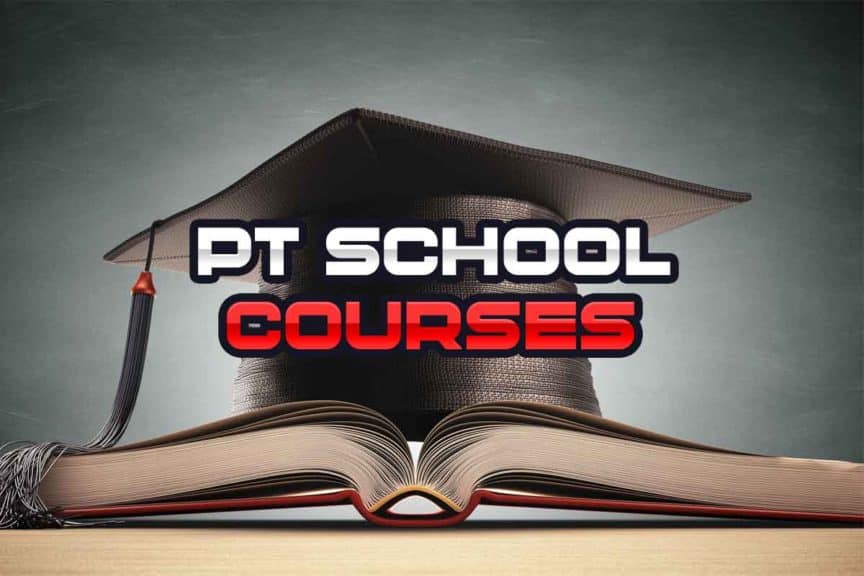What is PT school like in terms of coursework? Well, the short answer is that there’s A LOT of academic information to learn throughout PT school. But if you’re looking for a more in-depth answer than that, then I’ve got you covered within this article. But let’s start off with the quick answer and then I’ll start elaborating thereafter.
Students in a Doctor of Physical Therapy program within the US take coursework in anatomy, neurology, disease progression, exercise physiology, therapeutic exercise, research methodology, pediatrics, orthopedics and other didactic and lab-based material over an approximate three year timespan.
With all CAPTE-accredited PT schools in the US now being doctoral-level programs, students wishing become physical therapists must complete these courses throughout their schooling in order to earn their Doctor of Physical Therapy diploma. If all of these courses are successfully passed and the student graduates from their program, they are then eligible to write the National Physical Therapy Examination (NPTE), which is required to obtain licensure and practice as a physical therapist within the country.
These courses are designed to educate the student on obtaining an in-depth understanding of the human body in conjunction with intervention-based and rehabilitation-based techniques for a variety of conditions and populations across the entire lifespan of an individual. This article contains a specific list of courses (with general descriptions), broken down by category that are part of DPT curriculum across the US.
ARTICLE OVERVIEW:
The following bulleted points are quick links. Simply click/tap on any of them to instantly jump to that particular section of the article.
- The standardization of curricula for all PT students within the US
- Courses can have different names, but will ultimately cover the same subjects and material
- There is quite a bit of overlap between different categories of coursework
- List of categories and subsequent courses taken within each category
Standardized curriculum for all PT students within the US
The DPT curriculum is quite standardized across the US, with completion of all material covering the necessary prerequisite material and knowledge required to write the National Physical Therapy Examination, commonly known as the NPTE. This national board examination is administered by the Federation of State Board of Physical therapy (FSBPT).
It is this national exam that culminates the three years of study and coursework taken. Students who then successfully pass the exam are then eligible to receive their physical therapy license for any of the fifty states they register within, though sometimes they must also pass what is known as a jurisprudence exam for the state they wish to practice within.
Courses can have different titles, but largely cover the same and subjects and material
Before diving into the listed courses within this article, it is important to understand that courses can have vastly different names or titles from one school to the next, but they still cover the same topics, concepts and didactic material.
As an example, a course that covers the biomechanics of the human body may be titled “biomechanics” or may also be called “functional kinesiology” among other potential names. As a result, it’s important that you understand what the concepts of topics covered within each course are, rather than the actual course name. In other words, don’t get hung up or attached to the course names themselves, just focus on the topics of what they address.
There is often extensive overlap between different categories of coursework
It is also important to remember that there can be a large amount of categorical overlap from a course in one particular category into another category. This categorical overlap is in fact quite prevalent, and so you should understand that the list below is organized into single categories predominately for simplicity’s sake. In reality, one course may actually fit into multiple categories (and often does).
As an example, while a majority of coursework in PT school consists of learning about various disease-based processes and injury-based conditions, courses are often divided up based on the systems of the body and treatment techniques unique to the particular bodily system that has been affected. This means that a large majority of the coursework can be considered disease & injury-based coursework, but they are then sub-classified to another category within this list, again for simplicity’s sake.
As a more specific example: Courses in orthopedics of the body, (which are based largely around conditions, diseases, injuries and subsequent treatments that can all affect the musculoskeletal system) still have a heavy anatomical component to them, which means that one should also consider a course in orthopedics to be a sort of blend between an anatomy-based course in addition to a coursework where students learn about injuries and conditions that affect the anatomy of the body.
List of categories and subsequent coursework taken within each category
The following categorical list and the subsequent courses listed within each category comprise the general DPT curriculum for students within US schools:
Anatomy-based coursework
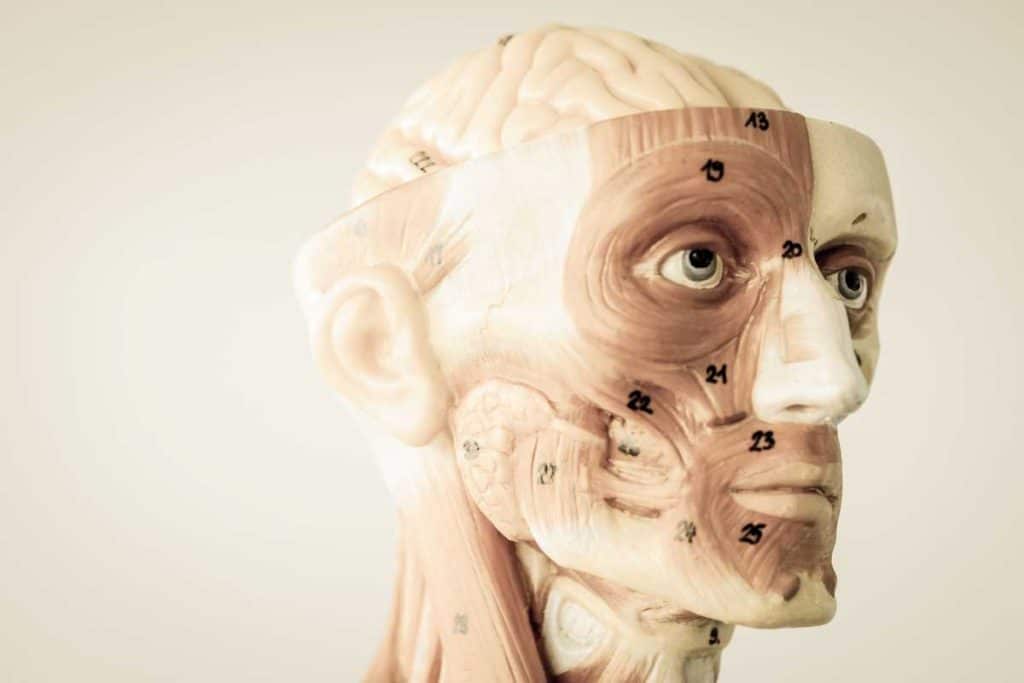
- Gross anatomy (with lab component)
- Functional anatomy (with lab component)
Gross anatomy (lecture with lab component)
Human gross anatomy is a lecture and laboratory course that uses a cadaver (the body of a diseased individual who has donated their body to the school/institution for research/learning-based opportunities of healthcare professionals and students) for the dissection of the body. The cadaver and various anatomical models are studied for illustrative purposes of anatomy.
There is a heavy emphasis that is placed on the anatomy of skeletal muscles, which includes bony attachments, nerves, blood vessels and functions and movements. Most gross anatomy courses also include additional dissections of abdominal and thoracic organs, anatomy of the head and the contents within the cranial cavity (contents inside of the skull).
Functional anatomy (lecture with lab component)
Functional anatomy is a course that builds upon the knowledge that students learn within their gross anatomy course. The course examines the relationship that exists between normal functional movement and dysfunctional movement within the body in regards to the functioning of the neuromusculoskeletal system (the interaction of the nervous system with the muscles, bones and joints of the body).
Functional anatomy looks at basic mechanics, biomechanics and movements (known as kinematics and kinetics) that are produced within the spine and the extremities of the human body. This is done through examining the body region by region while examining the specific anatomical features of each particular area.
This knowledge is critical for the aspiring therapist to be aware of in order to then be competent with the examination, evaluation and interventional techniques used for patients within a clinical-based environment.
Neurological-based coursework
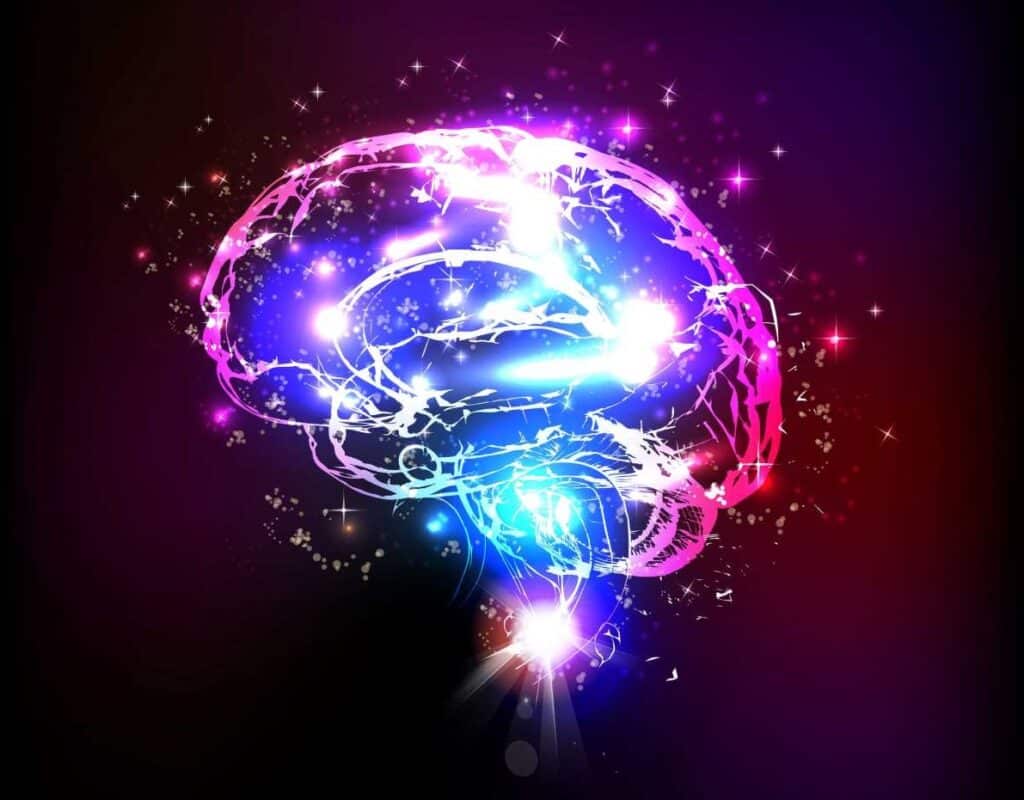
- Clinical neuroscience (with lab component)
- Neurodevelopmental physical therapy in pediatrics (with lab component)
- Neuromuscular assessment and intervention in the adult population (with lab component)
Clinical neuroscience (lecture with lab component)
Clinical neuroscience is a course that provides extensive, in-depth study of the behavior of the central nervous system and the peripheral nervous system and our current understanding of its various functions.
Physical therapists often deal with patients who have neurological conditions, diseases or injuries that have affected the neuromuscular system to one extent or another. Strong anatomical knowledge of the nervous system is therefore required for the physical therapist to have a better understanding as to what is taking place within the patient’s body.
This knowledge also helps the therapist to implement more effective clinical decision-making skills in regards to how to treat the patient’s rehabilitation process.
Neurodevelopmental physical therapy in pediatrics (lecture with lab component)
Neurodevelopmental physical therapy for pediatrics provides foundational knowledge for the examination and treatment of individuals within the pediatric population. There is a large emphasis on learning how the body develops with the primary first few years of life from a neurodevelopmental standpoint, as well as various conditions that can lead to disabilities within the pediatric population.
It also looks at examination, evaluation and interventional strategies that the physical therapist must use when working with or treating pediatric patients that have movement dysfunctions due to neurodevelopmental disorder(s).
Neuromuscular assessment and intervention in the adult population (lecture with lab component)
Neuromuscular assessment plays a primary and critical role for the clinical physical therapist. As a result, the student physical therapist must learn the foundation for conducting effective examinations for patients with neuromuscular-based conditions along with other conditions that may be chronic and disabling for a patient.
The student physical therapist must also learn effective treatment strategies for these individuals and be able to apply clinical-based reasoning for the selection and implementation of chosen interventions based on the patient’s individual condition and status.
Populations within this realm can include (but are certainly not limited to) individuals who have suffered a cerebrovascular accident (stroke), incurred a traumatic brain injury, populations with neurologically-based diseases, neurologically based developmental conditions (such as cerebral palsy), patients with amputations and various other neuromuscular-based injuries.
Cardiopulmonary-based coursework
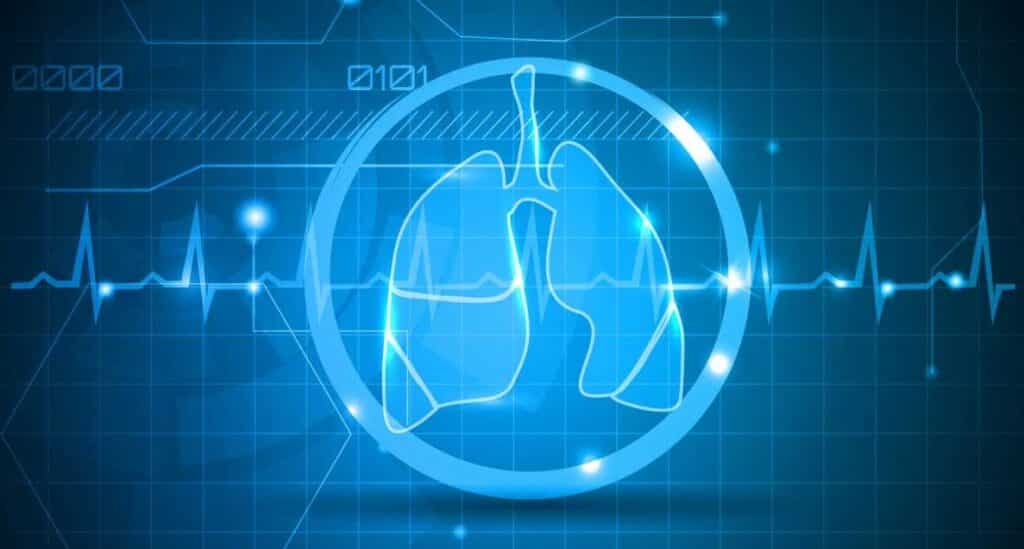
Patient management in cardiopulmonary physical therapy (lecture with lab component)
Physical therapists oftentimes work with patients who have compromised function of their heart and/or lungs. Physical therapy also has a specialty designation for physical therapists who wish to specialize in working with patient populations who have cardiopulmonary (heart and lung) conditions after graduating from PT school.
Coursework for patient management in cardiopulmonary physical therapy outlines and examines principles and treatment techniques that physical therapists may use when working with this type of patient population.
Different cardiovascular and pulmonary diseases are covered along with respective treatment techniques within the physical therapists scope. Cardiopulmonary assessment, medications, as well as exercise testing and exercise prescription are also covered.
Research-based coursework
- Research methodology and design
- Application of research methods in physical therapy
- Research seminar for Critically Appraised Topic
Research Methodology and design
With the profession of physical therapy striving to place a heavy emphasis on evidence-based practice, it is critical for physical therapists to be able to critically analyze the various aspects and components that comprise research design, research methodology as well as data collection and subsequent interpretation.
It is not enough for a therapist to read the latest scientific studies that may pertain to the profession or clinical application and accept the findings without critical analysis. The therapist should be competent enough to analyze and determine key components of studies, such as study design, statistical methods used, and other key features that can help the therapist and PT profession determine the validity of study and research findings.
Applications of research methods in physical therapy
It’s important that all entry level physical therapists have an understanding towards how academic research is performed and analyzed within the scientific and healthcare community.
Students should be familiar with ethical issues within studies as well as protection of human subjects within research.
Research seminar for Critically Appraised Topic
PT students within the US typically end their academic program through the completion of a Critically Appraised Topic (CAT), which is an academic paper that is written as a means to help fill an academic, research-based void within the current world of PT practice.
The CAT topic can be thought of as a thesis, however there is typically no original research undertaken by the PT student for their chosen topic. It is a paper that when researched and written with high academic standards can take a number of months to write, and can be well over fifty or sixty pages in length with over a hundred references cited throughout. Students have the option of publishing their paper if deemed to be a topic that helps fill the void within literature and if written to high enough standards.
My CAT topic in 2019 (in conjunction with my partner): The Effectiveness of Low-Load Blood Flow Restriction Training Versus Neuromuscular Electrical Stimulation on Enhancing Contractile Connective Tissue Properties in the Rehabilitation of Lower Extremity Dysfunction.
Disease & injury-based coursework
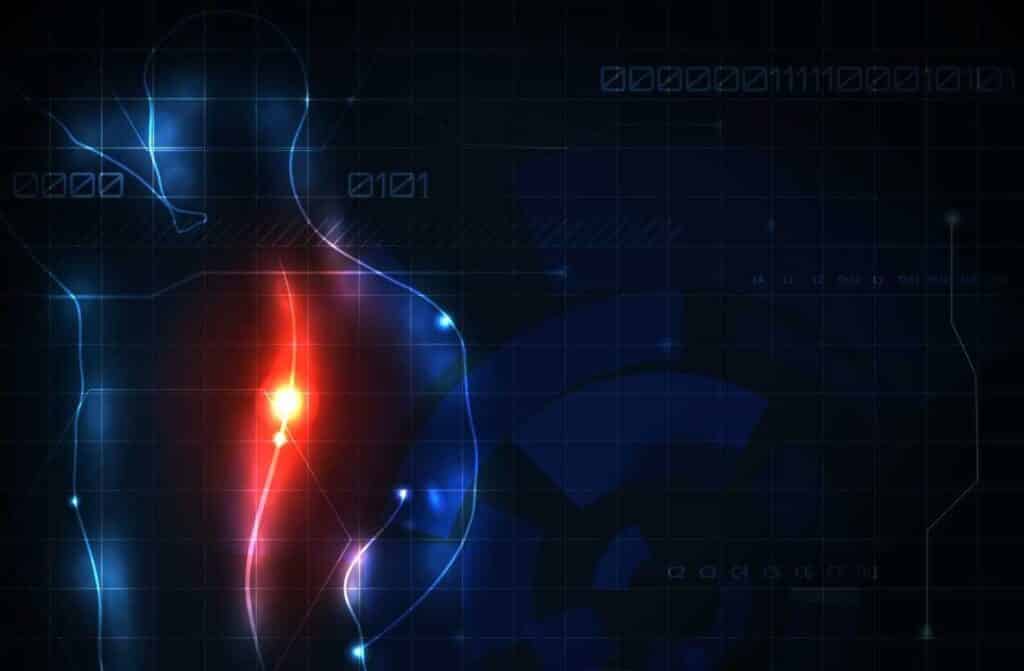
- Pathophysiology for physical therapists
- Patient management in rehabilitation physical therapy (with lab)
- Integumentary examination & intervention for physical therapists
- Lifespan development (with lab)
- Orthopedics of the spine (with lab)
- Orthopedics of the extremities (with lab)
- Differential diagnosis
Pathophysiology for physical therapists
Physical therapists must have a fundamental basis of knowledge pertaining to disease and the disease process that can occur within the body. This is essential knowledge for any healthcare provider as a means to provide both safe and beneficial treatment to the patient.
Pathophysiology covers basic foundations of human disease, including how they occur (ethology), how diseases can progress and how they may manifest (show up) within a patient. A basic pathophysiology course helps assist a physical therapy student in understanding key features of diseases in respect to inflammation, immune system responses, tissue healing, infection and other processes.
Patient management in rehabilitation physical therapy (lecture with lab)
This course examines the intervention and management that physical therapists provide for individuals affected by various neuromuscular disorders. Therapists must know how to effectively intervene and treat conditions of this nature throughout all stages of care and rehabilitation.
These conditions can include patients with vascular disease, systemic inflammatory diseases, amputations, spinal cord injuries, vestibular pathologies as well as conditions and disorders that are progressive and chronic in nature.
These populations may require prosthetic or orthotic devices as part of their physical needs, and it is therefore important that the physical therapist be well-versed in the prescription, proper fitting and application of these devices. The physical therapist must also understand their required role as an educator to the patient for successful and proper use of any required devices.
Physical therapists may also be required to be an advocate for the patients whom they treat and the importance of working with other healthcare professionals involved in the patient’s rehabilitation process across all stages of recovery or management.
Integumentary examination & intervention for physical therapists
The integumentary system refers to the skin of the human body. Physical therapists must often times treat or work within individuals who have various conditions or diseases that affect the health and/or function of their skin.
Physical therapists must therefore be well-versed in identifying the underlying mechanisms that can compromise health of the skin, what these skin conditions present as (i.e. what they look like) as well as treatment techniques that can benefit the patient.
A heavy emphasis is often placed on wound healing and risk factors that can lead to the development of various types of wounds that are often seen within specific populations treated by physical therapists.
Human development across the lifespan (lecture with lab)
Physical therapists must have a strong understanding of the physical, cognitive and psychosocial development of individuals across all ages and phases of life since they may treat populations that fit into any or all of these categories.
Therefore, they are required to take coursework that examines the field of pediatrics and geriatrics, along with all age groups in between. Coursework focuses on patient management of these populations as well as typical physiological and cognitive changes that occur throughout the human lifespan.
Orthopedics of the spine (lecture with lab component)
With physical therapists treating a high percentage of individuals with back pain, it is important that the PT student gains a solid framework in understanding the structure of the spine and conditions that can affect it. This includes the clinical ability to effectively identify, evaluate and formulate appropriate treatment plans and treatment techniques based on the nature and findings of the patient’s pain and/or dysfunction.
PT students are therefore required to learn and obtain competency with physical examination procedures based on spinal abnormalities and categorizing patients into different movement-based classifications or different pathoanatomical diagnoses.
Orthopedics of the extremities (lecture with lab component)
In addition to individuals who have back pain, physical therapists often must assess and treat the other joints, muscles and tissues of the arms and legs. Therefore, students must take coursework pertaining to examination, evaluation and intervention for those with pain and/or dysfunction of these areas of the body.
The PT student who wishes to enter clinical practice must therefore be competent in planning appropriate physical examination of the injured area along with performing an effective evaluation and interpretation of exam findings. Students must learn when and how to implement appropriate interventions to address functional limitations and disabilities. Such strategies often include manual therapy, exercise prescription and physical agents.
In order to be successful within this type of course, students must have a strong understanding of anatomical structures and functions of the limbs of the human body.
Differential diagnosis
Differential diagnosis refers to the process of ruling in or out the possible diseases and/or conditions that may be responsible for causing an individual’s symptoms.
Since physical therapists within the US are oftentimes a primary care provider for a patient, they must be able to identify important indicators of diseases and conditions that can affect the entire body. This is critical as it serves as a means to effectively identify either the correct physical therapy intervention(s) to employ or for the need to refer the patient to another, more appropriate healthcare provider based on the patient’s condition.
A differential diagnosis course can also include the introduction of basic skills required to determine key indications for radiographic testing in addition to interpreting information provided from these tests.
Physiology, exercise-based & movement-based coursework
- Physiology of therapeutic exercise (with lab)
- Advanced therapeutic exercise (with lab)
- Biomechanics & functional kinesiology for the physical therapist (with lab)
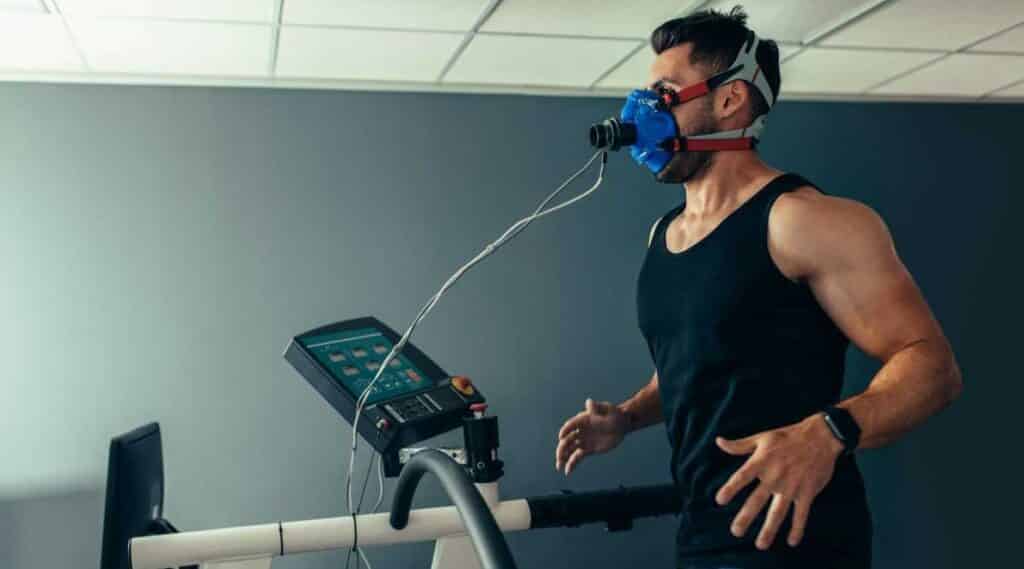
Physiology of therapeutic exercise – Exercise physiology (lecture with lab component)
Since physical therapists prescribe physical movement, exercise and activity in the treatment and rehabilitation of many of their patients, it is important that they have a strong foundational understanding in the physiological processes that occur as well as to how they occur when the human body produces movement of all types and intensities.
A physical therapy student must therefore must have conceptual and practical understanding of current exercise-related knowledge that comprise the cornerstone to providing a scientific basis for designing, implementing, observing and modifying exercises for patients with various levels of health.
Advanced therapeutic exercise (lecture with lab component)
In addition to the PT student gaining an understanding of human physiology during exercise and physical activity, they must also develop a strong theoretical and conceptual basis for the clinical application of therapeutic exercises that are frequently employed by physical therapists.
This material can cover indications and contraindications for specific types of exercise based on the patient’s current status, precautions and techniques for implementing various types of exercise and movement-based interventions. It also covers clinical reasoning, evidence-based practice and considerations for various types of populations whom the therapist may treat.
Biomechanics & functional kinesiology for the physical therapists (lecture with with lab component)
Since one of the primary roles of the physical therapist is the prevention, evaluation and clinical management of movement-based dysfunctions, PT students must develop a thorough understanding and mastery of biomechanical and kinesiological principles as a means to effectively analyze and explore movement-based disorders.
A biomechanics course typically aims to take foundational concepts and then integrate them into whole-body motions and postures, which are often more complex in regards to analysis. The analysis and movement potential and movement of joints, postures and tissues are analyzed throughout the entire body. Biomechanics can also have a high emphasis on the analysis of normal human gait (walking) in addition to analysis of various types of alteration in gait mechanics that arise from pathological processes.
Professional skills & competency-based coursework

- Basic clinical skills (lecture with lab component)
- Introduction to therapeutic modalities (lecture with lab component)
- Professional development coursework (may be multiple courses)
Basic clinical skills (lecture with lab component)
Physical therapy students must have a foundational understanding and ability to perform clinical skills that are essential to entry-level practice. An introductory skills or basic skills course is taken for these reasons.
This type of course will provide students with the necessary knowledge and practice of skills such as manual muscle testing (MMT) for muscular strength, joint mobility assessment throughout the body, the ability to take a patient’s vital signs, performing proper transferring of patients, proper use of assistive devices as well as basic functional screening of the upper and lower body.
A basic or introductory skills course also look at proper medical charting and documentation techniques required for the physical therapist.
Introduction to therapeutic modalities (lecture with lab component)
Physical therapists must be well-versed in different treatment modalities that are common to the field of physical therapy. As a result, students will spend time in a course that covers the study, proper use of, and clinical reasoning as to incorporating therapeutic modalities into patient rehabilitation. This includes common modalities such as neuromuscular electrical stimulation (NMES) devices, therapeutic ultrasound devices, thermal modalities, cryotherapy modalities, and others.
Professional development coursework (may be multiple courses)
Physical therapists are required to be effective communicators in their clinical role, both when communicating to patients as well as other physical therapists and healthcare providers.
A course that covers the awareness towards the need for competencies such as communication, multi-cultural awareness and professional issues that pertain to the profession of physical therapy is required for physical therapy students in order to ensure professional behavior in the clinical environment.
A second professional development course may be offered, in which case will continue to build upon and enhance the knowledge and understanding of effective communication skills that are required of the physical therapist when in the practice-based setting.
Clinical-environment-based coursework (clinical rotations)
Clinical fieldwork internship rotations
Physical therapy students are required as part of the DPT curriculum to complete a specified number of hours within clinical environments. This is done over multiple rotations within different clinical placements (inpatient and outpatient settings).
While the number of clinical placements may differ from one school to another, and the specific number of weeks at each respective placement may also differ, students typically acquire approximately 30 or more weeks of full-time clinical practice hours.
Students are also typically required to complete in service presentations to staff members at each clinical placement as part of their clinical requirements.
Other coursework
- Pharmacology for rehabilitation specialists
- Introduction to physical therapy & healthcare systems
- Client education, advocacy and consultation
- Health & wellness promotion in physical therapy
- Business management strategies for physical therapists
- Multiple graduate elective courses
- NPTE examination prep course (0 credits)
Pharmacology for rehabilitation specialists
While physical therapists are by no means pharmacologists, they oftentimes work with patients who rely on medications as part of their healthcare treatment. Physical therapists must have a fundamental knowledge of common pharmaceutical drugs that are commonly seen within patients.
A basic pharmacology course for PT students aims to present an overview of pharmacological management for patients with acute and chronic medical conditions that are related to the profession of rehabilitative sciences. It also examines the basic actions, interactions, precautions and potential and/or common side effects of pharmaceutical drugs.
Introduction to Physical Therapy & Healthcare systems
It’s essential for physical therapists within the US to have a fundamental knowledge base pertaining to the country’s healthcare system. Students must also have an understanding as towards the general role of the physical therapist within the healthcare model, along with their respective scope of practice. They must also have an understanding towards practice standards and ethical codes to follow.
Client education, advocacy and consultation
Client education, advocacy and consultation helps the physical therapy student to further their educator skills and continue to pursue their abilities to advocate and work with individuals in the realm of rehabilitative science. Students within this type of course gain and apply knowledge of these theories and constructs related to their role as a physical therapist within the healthcare profession.
Health & wellness promotion in physical therapy
With physical therapists being primary healthcare providers within the US, the promotion of health and wellness is seen as one of the core values within the profession.
Disease and injury prevention, wellness and health are all concepts that are advocated by the profession of physical therapy.
It is therefore important that the physical therapy student (and soon to be clinician) have an understanding of basic models of individual health beliefs & behaviors, attitudes towards health and applications of health maintenance and disease prevention. Physical therapists should have a basic understanding in implementing individual and community-wide health initiatives.
Business management strategies for physical therapists
With a high percentage of licensed physical therapists opening their own private practice clinics, many PT schools include within their curriculum an introductory course to business management strategies that are unique to the private-practice demands of physical therapists. This type of course therefore aims to better equip the physical therapist with foundational knowledge for business management along with discussion of current issues within the profession of private practice physical therapy.
NPTE examination preparation (0 credits)
As students near completion of their entire curricula, they must begin to focus their efforts on studying for the National Physical Therapy Examination, which is the nation-wide board exam for physical therapists to enter into clinical practice.
Some schools (not all), will mandate that students take an on-campus review course (typically held over a weekend) in which students learn all about the framework of the NPTE, including what it specifically consists of, self-assessment, developing individual study plans, assessing individual strengths and weaknesses and much more.
Multiple graduate elective courses
Students in PT school within the US typically have a handful of graduate-level elective coursework that they must complete. These courses do not need to specific to PT coursework (i.e. they can be taken in other departments), but must be graduate-level courses.
Concluding remarks:
Students who wish to complete a Doctor of Physical Therapy program within the US are required to take a standardized curricula of material comprising both didactic coursework as well as hands-on laboratory-based work. These courses typically take three full-time academic years to complete, with many institutions requiring coursework throughout summer semesters in addition to fall and spring semesters.
Coursework aims at preparing the PT student for having a baseline of clinical knowledge and skills required to write and successfully pass the NPTE board exam, which students must pass before being eligible to obtain a physical therapy license. This curricula covers material ranging from knowledge of the human body, diseases and conditions that affect health and movement, proper therapeutic treatment techniques, knowledge of healthcare systems, scientific reasoning and appropriate clinical decision-making.
While there may be small variations in curricula covered from one school to another, coursework is largely standardized by the CAPTE in order to ensure that all PT students have the fundamental knowledge for writing the national board exam and ensuring that they have the fundamental knowledge to enter professional practice as a physical therapist.

Hi! I’m Jim Wittstrom, PT, DPT, CSCS, Pn1.
I am a physical therapist who is passionate about all things pertaining to strength & conditioning, human movement, injury prevention and rehabilitation. I created StrengthResurgence.com in order to help others become stronger and healthier. I also love helping aspiring students and therapists fulfill their dreams of becoming successful in school and within their clinical PT practice. Thanks for checking out my site!

